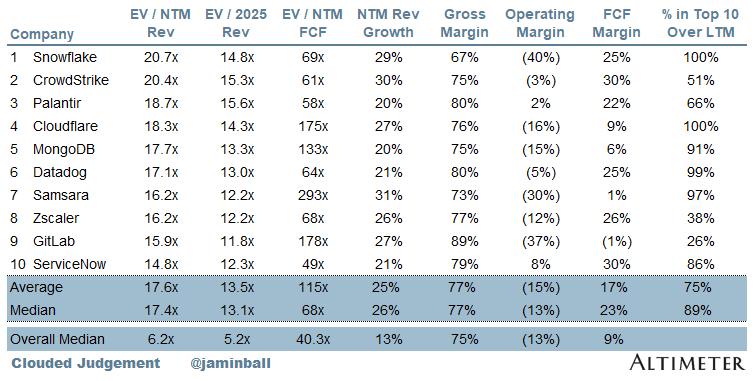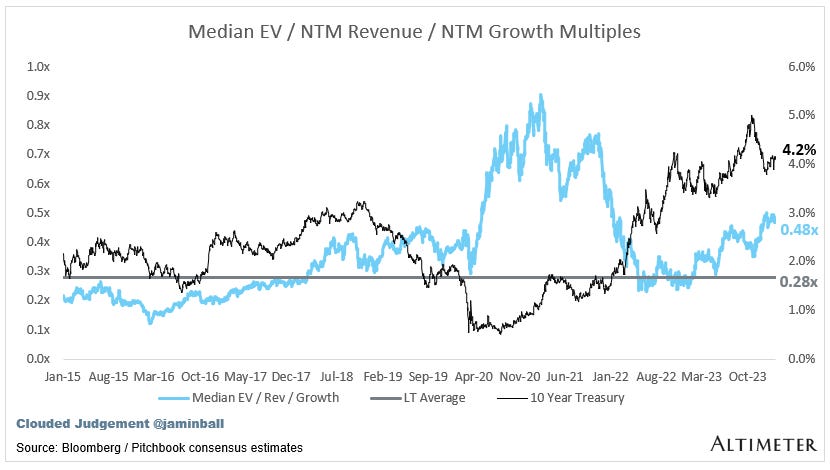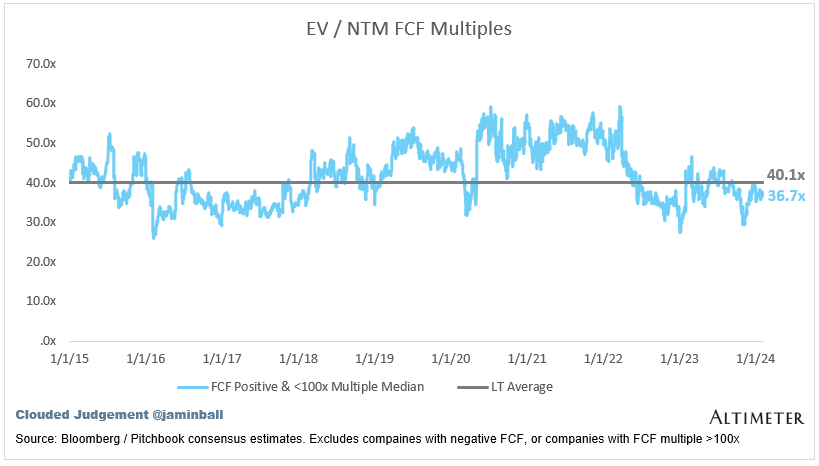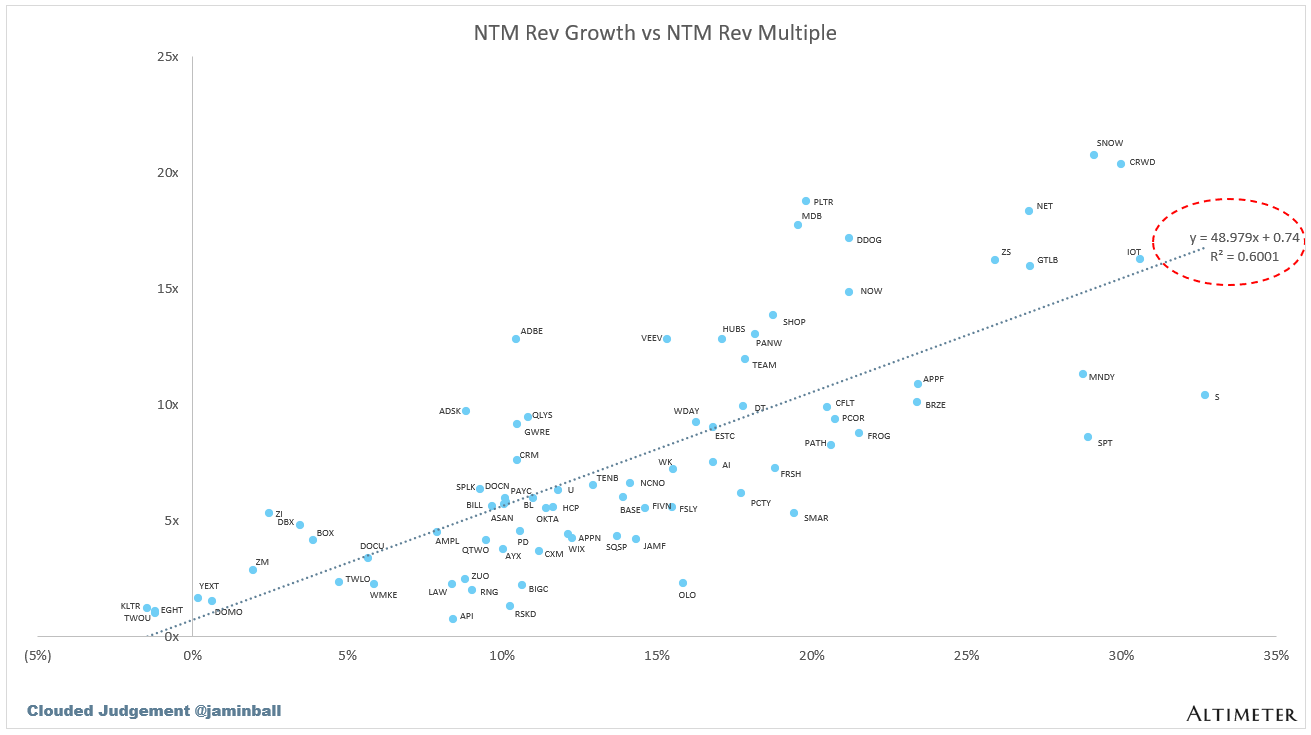Every week I’ll provide updates on the latest trends in cloud software companies. Follow along to stay up to date!
Are Forward Estimates Going Up?
Going in to this earnings season I expected a big driver of stock price performance to be how 2024 full year estimates change pre / post earnings. Since the macro feels more “stabilized” it felt fair to assume “are numbers going up or down” to be the question most correlated with stock price performance. After a few software companies have reported we can start to look at the data behind “are numbers going up.” Surprisingly, despite the huge moves in stock price (Palantir / Confluent both +30% and Cloudflare was +20% after hours yesterday), we really haven’t seen forward estimates change that much. The chart below shows how companies’ 2024 guidance compares to consensus estimates prior to the earnings call. Confluent guided 1.4% ahead. Palantir 0.3%. Cloudflare 0.1%. So far, we’re seeing really big moves in stock prices full year estimates probably staying relative constant. Part of this could be conservative guides being called out (Confluent kind of said this about their guide when they said “if you look at our Q1 and full year guidance, we're not assuming a huge amount of acceleration in the second half of the year. So that -- I mean when you combine all of these, it just gives us, I'd say, more confidence around our 2024 guidance”). Or the market was positioned for weaker earnings with a lot of shorts, and results weren’t bad enough to justify keeping the shorts on and there’s widespread short covering. Either way, multiple expansion is happening quickly in some areas as valuations go up, but estimates remain largely unchanged. The chart below shows the data for the companies to report so far (those who give full year guidance).
SBC / Dilution
SBC goes in and out of being a hot topic of conversation, but it’s something every startup founder should always be thinking about. On Confluent’s earnings call this week they very explicitly called out the effects of their dilution over the last couple years, and where they project it to be. They said:
“Finally, we are pleased with decreasing our annualized net dilution from 4.7% in fiscal year '22 to 3.5% in fiscal year '23. We expect net dilution for fiscal year '24 would be approximately 3%, in line with our midterm target. Our goal over the long term is to bring net dilution down to under 2%."
For startups, dilution from employee hiring isn’t always top of mind. An option pool is typically refreshed with each venture round, and then new hires “burn down” that pool over time. So there really isn’t incremental dilution per se with each incremental option grant, but instead a step function change in dilution with each round when the pool is refreshed.
I think dilution should be front and center for every startup. What I like to see is a quarterly dilution waterfall, in the same way every company reports a quarterly ARR waterfall. Start with the shares outstanding at the start of the quarter (common, preferred and all vested / unvested granted options). Then add a line for new grants in the quarter. Next line is canceled options (employee departures with unvested), and the final line is the total shares at the end of the quarter which aggregates the first three lines. Also good to track how much of the option pool remains.
I know every company does track this in some respect. But I think it should be front and center of every board deck the same way ARR is. Equity dilution can become a bad habit that’s hard to reverse. And over time it can become very costly. Making a point to explicitly track and report it to the board starts creating good habits. If you’re net options granted (new option grants less canceled options) throughout the year is >5% of the starting total shares, you’re probably creating bad habits. Goal should be 2-5% / year, where you’re only close to that 5% if you’re making key C Level exec hires who individually take 1%+
Quarterly Reports Summary
Top 10 EV / NTM Revenue Multiples
Top 10 Weekly Share Price Movement
Update on Multiples
SaaS businesses are generally valued on a multiple of their revenue - in most cases the projected revenue for the next 12 months. Revenue multiples are a shorthand valuation framework. Given most software companies are not profitable, or not generating meaningful FCF, it’s the only metric to compare the entire industry against. Even a DCF is riddled with long term assumptions. The promise of SaaS is that growth in the early years leads to profits in the mature years. Multiples shown below are calculated by taking the Enterprise Value (market cap + debt - cash) / NTM revenue.
Overall Stats:
Overall Median: 6.3x
Top 5 Median: 19.5x
10Y: 4.2%
Bucketed by Growth. In the buckets below I consider high growth >30% projected NTM growth, mid growth 15%-30% and low growth <15%
High Growth Median: 16.2x
Mid Growth Median: 10.0x
Low Growth Median: 4.4x
EV / NTM Rev / NTM Growth
The below chart shows the EV / NTM revenue multiple divided by NTM consensus growth expectations. So a company trading at 20x NTM revenue that is projected to grow 100% would be trading at 0.2x. The goal of this graph is to show how relatively cheap / expensive each stock is relative to their growth expectations
EV / NTM FCF
The line chart shows the median of all companies with a FCF multiple >0x and <100x. I created this subset to show companies where FCF is a relevant valuation metric.
Companies with negative NTM FCF are not listed on the chart
Scatter Plot of EV / NTM Rev Multiple vs NTM Rev Growth
How correlated is growth to valuation multiple?
Operating Metrics
Median NTM growth rate: 13%
Median LTM growth rate: 19%
Median Gross Margin: 75%
Median Operating Margin (13%)
Median FCF Margin: 9%
Median Net Retention: 112%
Median CAC Payback: 38 months
Median S&M % Revenue: 43%
Median R&D % Revenue: 26%
Median G&A % Revenue: 16%
Comps Output
Rule of 40 shows rev growth + FCF margin (both LTM and NTM for growth + margins). FCF calculated as Cash Flow from Operations - Capital Expenditures
GM Adjusted Payback is calculated as: (Previous Q S&M) / (Net New ARR in Q x Gross Margin) x 12 . It shows the number of months it takes for a SaaS business to payback their fully burdened CAC on a gross profit basis. Most public companies don’t report net new ARR, so I’m taking an implied ARR metric (quarterly subscription revenue x 4). Net new ARR is simply the ARR of the current quarter, minus the ARR of the previous quarter. Companies that do not disclose subscription rev have been left out of the analysis and are listed as NA.
Sources used in this post include Bloomberg, Pitchbook and company filings
The information presented in this newsletter is the opinion of the author and does not necessarily reflect the view of any other person or entity, including Altimeter Capital Management, LP ("Altimeter"). The information provided is believed to be from reliable sources but no liability is accepted for any inaccuracies. This is for information purposes and should not be construed as an investment recommendation. Past performance is no guarantee of future performance. Altimeter is an investment adviser registered with the U.S. Securities and Exchange Commission. Registration does not imply a certain level of skill or training.
This post and the information presented are intended for informational purposes only. The views expressed herein are the author’s alone and do not constitute an offer to sell, or a recommendation to purchase, or a solicitation of an offer to buy, any security, nor a recommendation for any investment product or service. While certain information contained herein has been obtained from sources believed to be reliable, neither the author nor any of his employers or their affiliates have independently verified this information, and its accuracy and completeness cannot be guaranteed. Accordingly, no representation or warranty, express or implied, is made as to, and no reliance should be placed on, the fairness, accuracy, timeliness or completeness of this information. The author and all employers and their affiliated persons assume no liability for this information and no obligation to update the information or analysis contained herein in the future.




















Hi Jamin, for your equation inputs, are you using a combination of current info (ie stock price today to calculate Market Cap) and most recent filing (ie Cash, Debt) ?
I'm trying to use your method for some companies you don't cover and want to figure out data sources.
BTW, your newsletters are AWESOME !!
Thank you
Thanks so much for the info as always! in addition to revenue estimates, could you also start share RPO estimates versus consensus? I'm told that PLTR and NET's big move were driven by RPO, thank you!